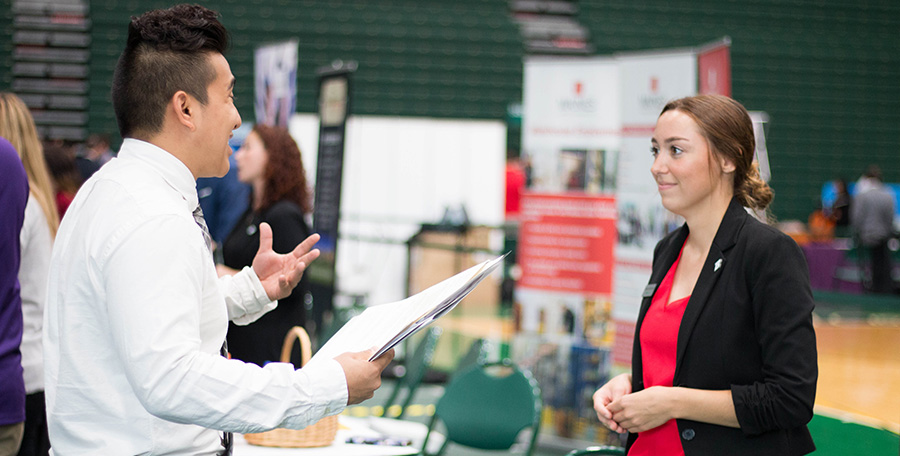Career Readiness Emerges as a Priority

The following article was written by Binghamton University Assistant Vice President of Student Success, Kelli Smith, Ph.D. and published in the 100th Anniversary Edition of Leadership Exchange Magazine for Chief Student Affairs Officers.
Increasing student debt, rising tuition costs, greater expectation for return on investment, and a post-2008 recession have heightened calls for greater accountability at higher education institutions. Employers are increasingly concerned that graduates are not prepared to compete in a global economy and lack the skills to be contributing employees. The stakes are high, and the result is a fascinating time within the field of career education—a golden age of the profession, according to some practitioners. It is now commonplace for institutions to formally recognize the value of student success and career readiness in their mission statements and strategic plans, and to back up their commitment with significant resources and elevation of career services on campuses. Career centers are finally being recognized for their contributions to recruitment, retention, and revenue (the three Rs), and career readiness of college graduates is perceived as a significant contribution that higher education can make to the labor market and future citizenship. Additionally, more faculty and administrators within the ivory towers are beginning to embrace the idea that efforts to prepare students for success are neither undesirable nor mutually exclusive to the traditional values of a liberal arts education.
Career education is riding a wave of transformation across the United States and worldwide.
Trends indicate a new recognition of the value of career education units to students,
employers, parents, alumni, and local and regional economies, warranting new investment
in career readiness as a campus-wide priority. Three prominent themes are at the core
of this transformation.
Effective partnership hubs. As the expectations and missions of career centers have expanded, so have the necessary
partnerships as more institutions understand the student career success must be articulated
and supported as an institutional priority to be successful. It makes logical sense
for career services to be the champion of career education efforts, even if career
centers do not own every part of the process. Their role is shifting from a peripheral
or siloed functional area to a strategic, systemic leader advancing an institutional
priority. While this will look different for every college or university, relationship
building is crucial for all institutions. It also takes significant time to develop
effective partnership hubs. On-campus partnerships must be forged with admissions,
orientation, academic advising, marketing and communications, advancement, academic
support programs, residential life, diversity-related departments, alumni affairs,
institutional research and assessment offices, college leadership, faculty, and students.
Potential external partners include employers, local and regional economic development
units, boards of government, parents, and vendors. In effect, the expected and necessary
partnerships are so numerous that they effectively create a culture of career readiness
as "everyone's business".
Elevation of career services. Given the complexity, expectations, and skill sets required, what has historically
been a career center director role is now often elevated to an associate professor,
or associate vice president position. In fact, in the case of the University of California,
Irvine, the career operation is now its own division, signaling its importance. Today,
rather than combined units, the career services director role regularly includes overseeing
single units, such as career education, internship programs, or employer services,
since each is complex enough to require director-level leadership. Resources are prioritized
to help career centers succeed, and state-of-the-art facilities are showcased to students
early, avoiding student claims that they do not know where the career center is located.
While a good number of institutions experience high expectations with little leadership
support, this is no longer the norm for forward-thinking institutions.
Innovative approaches. Early engagement of students and new ways of connecting are key to success. The career
center is now the first stop for many admissions tours and plays a key role in crafting
the institutional message. A strong presence of orientation, especially for family
sessions that focus on the importance of internships and job experiences, is now commonplace.
Innovative ways to help students get more clarity in their career goals, gain experience,
connect with alumni and employers, and build skills needed in today's economy are
constantly developed and successfully implemented. Student professional development
has an expanded mission. New approaches are constantly being created to meet students
where they are—both physically and developmentally. For example, Stanford University's,
BEAM Center, a career education hub, started "pop-up events" around campus, and Binghamton
University built on its faculty-in-residence culture with the creation of career consultants-in-residence.
Pop-ups, housing staff offices within residential communities, and casual events such
as "Making S'More Connections" have achieved incredible success in expanding reach.
The individual appointment model alone no longer works and is merely one aspect of
a career center as expectations grow and the field looks for more effective ways to
connect with and deliver career education to students. Operational efficiencies, such
as allowing student employers or vendors to conduct resume reviews, help give staff
greater capacity for more complex tasks, such as faculty and alumni relationship building,
and deeper levels of assistance to students.
While career centers are, one could argue, among the best units within higher education at developing effective partnerships and strategies to broaden reach, even career professionals doing the best work in this space often miss those students who need help the most, particularly students that arrive on campus with less social capital and privilege. Therefore, many institutions are choosing to integrate career preparation into the curriculum for all students, requiring closer connections with academic affairs. Other strategies to reach more students have included transforming student employment to a high-impact learning experience that develops skills applicable to future careers.
For student affairs and career education professionals who have craved upper-level
leadership assertion to career services and the resources required to expand their
reach, it is the best of times. The wave of change and support has been swift, and
it is likely to continue.